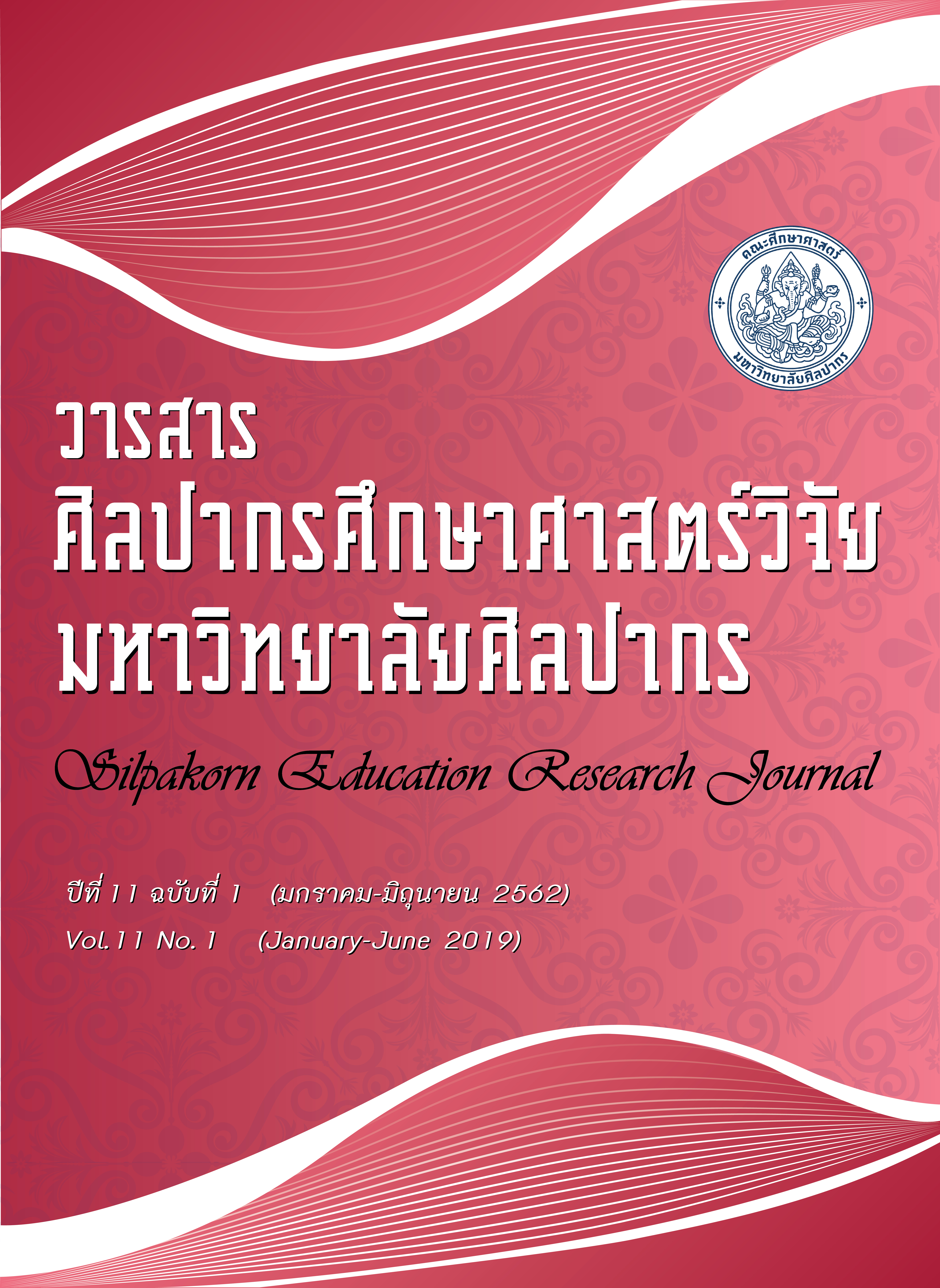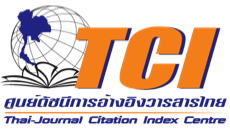ผลของการเข้าร่วมกิจกรรมการละเล่นไทยที่มีต่อการพัฒนาความคิดสร้างสรรค์ในเด็กปฐมวัย (Effects of Participating with Thai Traditional Play Activities on Creative Thinking in Preschooler)
คำสำคัญ:
การละเล่นไทย/ ความคิดสร้างสรรค์/ เด็กปฐมวัยบทคัดย่อ
การวิจัยนี้ มีวัตถุประสงค์เพื่อเปรียบเทียบ 1) ความคิดสร้างสรรค์ก่อนเข้าร่วมกิจกรรมการละเล่นไทย กับหลังเข้าร่วมกิจกรรม ระยะที่หนึ่ง 2) ความคิดสร้างสรรค์ก่อนเข้าร่วมกิจกรรมการละเล่นไทย กับหลังเข้าร่วมกิจกรรม ระยะที่สอง 3) ความคิดสร้างสรรค์ในเด็กปฐมวัยที่เข้าร่วมกิจกรรมการละเล่นไทย กับเด็กปฐมวัยที่ไม่ได้เข้าร่วมกิจกรรม ระยะที่หนึ่ง 4) ความคิดสร้างสรรค์ในเด็กปฐมวัยที่เข้าร่วมกิจกรรมการละเล่นไทย กับเด็กปฐมวัยที่ไม่ได้เข้าร่วมกิจกรรม ระยะที่สอง
กลุ่มตัวอย่างเป็น เด็กปฐมวัยชั้นอนุบาล 2 จำนวน 35 คน 18 คนอยู่ในห้องทดลอง 17 คนอยู่ในห้องควบคุม เครื่องมือที่ใช้ 1) แผนกิจกรรมการละเล่นไทย 2) แบบทดสอบความคิดสร้างสรรค์ Torrance Test of Creative Thinking สถิติที่ใช้ได้แก่ ค่าเฉลี่ย ส่วนเบี่ยงเบนมาตรฐาน สถิติ Wilcoxon Signed Ranks Test และ Mann-Whitney U Test ผลพบว่า 1) ความคิดสร้างสรรค์ของเด็กปฐมวัย หลังเข้าร่วมกิจกรรมการละเล่นไทยระยะที่หนึ่ง สูงกว่าก่อนเข้าร่วมกิจกรรม 2) ความคิดสร้างสรรค์ของเด็กปฐมวัยหลังเข้าร่วมกิจกรรมการละเล่นไทยระยะที่สอง สูงกว่าก่อนเข้าร่วมกิจกรรม 3) ภายหลังการเข้าร่วมกิจกรรมการละเล่นไทยระยะที่หนึ่ง ความคิดสร้างสรรค์ของเด็กปฐมวัยที่เข้าร่วมกิจกรรมไม่สูงกว่าเด็กปฐมวัยที่ไม่ได้เข้าร่วมกิจกรรม และ 4) ภายหลังเข้าร่วมกิจกรรมการละเล่นไทยระยะที่สอง ความคิดสร้างสรรค์ของเด็กปฐมวัยที่เข้าร่วมกิจกรรมสูงกว่าเด็กปฐมวัยที่ไม่ได้เข้าร่วมกิจกรรม
เอกสารอ้างอิง
Changkuen, P. (2001). Korat Traditional Play: Analyzing the Value of Physical Education and Folklore. Master Thesis, Graduate School Khonkaen University.
พรพนา ช่างเกวียน. (2544). การละเล่นพื้นเมืองโคราช: การวิเคราะห์คุณค่าทางด้านพลศึกษาและคติชนวิทยา. วิทยานิพนธ์ศึกษาศาสตรมหาบัณฑิต, บัณฑิตวิทยาลัย มหาวิทยาลัยขอนแก่น.
Phanakij, P. & Nillapun, M. (2016). “Development of an Instructional Model to Enhance Creative Problem Solving Ability and Scientific Innovation for Primary School Students”. Silpakorn Educational Research Journal, 8(2), 192-204.
พีชญาณ์ พาหะกิจ และมาเรียม นิลพันธุ์. (2559). “การพัฒนารูปแบบการสอนเพื่อส่งเสริมความสามารถในการแก้ปัญหาอย่างสร้างสรรค์และนวัตกรรมทางวิทยาศาสตร์ของนักเรียนชั้นประถมศึกษา”. วารสารศิลปากรศึกษาศาสตร์วิจัย, 8(2), 192-204.
Punmanee, A. (2012). Research Report: Finding Normal Criteria for Creativity Measurement of Grade 1-6 Students in Bangkok. Kasem Bundit University.
อารี พันธ์มณี. (2555). รายงานการวิจัยการหาเกณฑ์ปกติของแบบวัดความคิดสร้างสรรค์ของนักเรียนชั้นประถมศึกษาปีที่ 1-6 ในเขตกรุงเทพมหานคร. มหาวิทยาลัยเกษมบัณฑิต.
Punmanee, A. (2014). Practice to Think, Think Creatively. Bangkok: Printing of Chulalongkorn University.
อารี พันธ์มณี. (2557). ฝึกให้คิดเป็น คิดให้สร้างสรรค์. กรุงเทพฯ:โรงพิมพ์แห่งจุฬาลงกรณ์มหาวิทยาลัย.
Suwannatep, P. (2015). “The study of childhood’s progress according to the desirable characteristies standard by using Thai folk amusement activities”. Silpakorn Educational Research Journal, 7(1), 256-269.
ปิยะนุช สุวรรณเทพ และสุเทพ อ่วมเจริญ. (2558). “การศึกษาพัฒนาการของเด็กปฐมวัย ตามมาตรฐานคุณลักษณะที่พึงประสงค์ โดยการจัดกิจกรรมการละเล่นไทย สำหรับเด็กปฐมวัย”. วารสารศิลปากรศึกษาศาสตร์วิจัย, 7(1), 256-269.
ภาษาต่างประเทศ
Baas, M., De Dreu, C. K. W., & Nijstad, B. A. (2008). “A meta-analysis of 25 years of mood-creativity research: hedonic tone, activation, or regulatory focus?” Psychological Bulletin, 134(6), 779-806. Doi: 10.1037/a0012815.
Baas, M., Nevicka, B., & Ten Velden, F.S. (2014). “Specific mindfulness skills differentially predict creative performance”. Personality and Social Psychology Bulletin, 40(9), 1092-1106.
Bayram, M. (203). “The Design playground”. Design Management Review, 42-49. Doi: 10.1111/drev.10228/epdf.
Bergen, D. & Fromberg, D. P. (2009, February). “Play and social interaction in middle childhood”. Phi Delta Kappan, 426-430. Retrieved from https://pdk.sagepub.com/content/90/6/426.extract.
Frost, J. L., Wortham, S. C. & Reifel, S. (2012). Play and Child Development. New Jersey: Pearson Education.
Garaigordobil, M. & Berrueco, L. (2011). “Effects of a play program on creative thinking of preschool children”. The Spanish Journal of Psychology. 14(2), 608-618. Doi: org/10.5209/rev_SJOP.2011.v 14.n2.9.
Gregory, E., Hardiman, M., Yarmolinskaya, J., Rinne, L., & Limb, C. (2013). “Building creative thinking in the classroom: From research to practice”. International Journal of Educational Research, 62, 43-50.
Gliner, J. A., Morgan, G. A., & Leech, N. L. (2011). Research Methods in Applied Settings: An Integrated Approach to Design and Analysis (Second Edition). Abingdon: Taylor & Francis.
Haupt, M. (2007, March). “The value of play”. Young Children, 94-95. Retrieved from
www.naeyc.org/resources/journal/.
Johnson, J.E., Christie, J.F. & Yawkey, T.D. (1999). Play and Early Childhood
Development (2nd ed.) New York: Longman.
Leggett, N. (2017). “Early childhood creativity: Challenging educators in their role to intentionally develop creative thinking in children”. Early Childhood Education Journal, 45, 845-853. Doi: 10.1007/s10643-016-0836-4.
Mistrett, S. & Bickart,T. (2009, May-June). “Child’s play: The best way to learn”.
Early Childhood, 18-22. Retrieved from www.middleeasteducator.com/.
Russ, S.W. & Dillon, J. A. (2011). “Changes in children’s pretend play over two decades”. Creative Research Journal, 23(4), 330-338. Doi: 10.1080/10400419.2011.621824.
Russ, S.W. & Wallace, C. E. (2013). “Pretend play and creative process”. American Journal of Play, 6(1), 136-148.
Veselack, E., Cain-Chang, L., & Miller, D.L. (2010). Yong Children Develop Foundational Skills Through Child-Initiated Experiences in a Nature Explore Classroom: A Single Case Study in La Canada, California. Retrieved from: https://dimentionsfoundation.org/finding.html.





